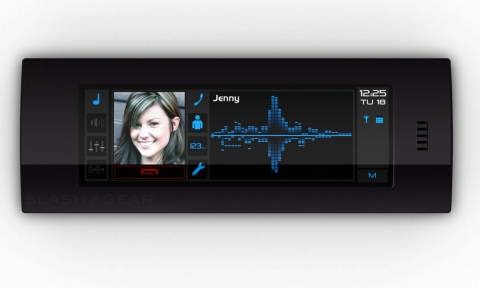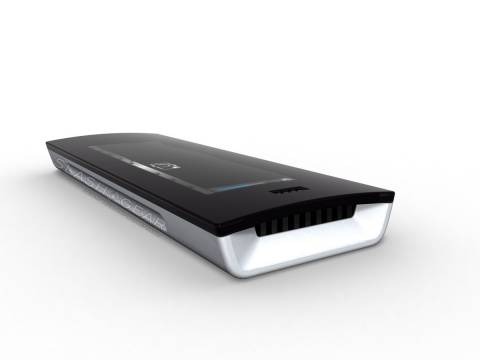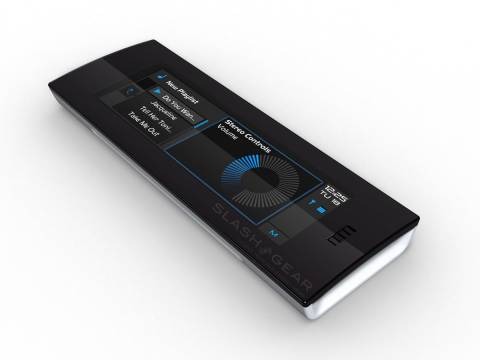Synaptics And Pilotfish Collaborate To Develop Next Generation Mobile Phone Concept
SlashGear has received a press release and an internal document about Onyx, a collaborative cellphone project by touch-sensor specialists Synaptics and industrial design wizards Pilotfish. Unlike many concepts, where a sleek, headline grabbing shell either runs standard software or nothing at all, or a new platform runs on bland reference hardware, part of the charm of Onyx comes from the harmony of the software/hardware interface. In fact it's this interface – and your interaction with it – that potentially makes Onyx the product of 2006.

"The real meaning of this product is about opening up the channels between hand, eyes, and device, and giving people access to actions and information in a way not possible with conventional buttons" [Brian Conner, Pilotfish]
To call the Onyx touchscreen-based is to do it a disservice; in fact, it uses Synaptics innovative ClearPad technology, the first transparent touch-sensitive capacitive sensor. ClearPad is capable of recognizing not only points and taps but also shapes and complex movements, together with multi-point input. At 0.5mm thick, the sensor layer can recognize touch and gestures through up to 1.6mm of plastic, making it far more durable and optically clear than traditional multi-layer touchscreens. And above and beyond those touchscreens it can recognize one or two finger contact, a finger used on its side, or even different body parts; a phone call to Onyx can be answered by simply holding it to your cheek, messages sent by swiping them off the screen with the whole finger.

Clever stuff, but the joy of Onyx comes from the cutting-edge industrial design and user interface design package provided by Pilotfish. Working closely with Synaptics to eke out the best of ClearPad's capabilities, Pilotfish have followed the philosophy that hardware and software are not two separate fields but rather interrelated parts of the overall experience of a product.
"The design statement of the physical product itself is very simple: it's all about the living, interactive surface that presents itself to the user and everything else is secondary. The main display and interaction surface is a curved optical panel over the large LCD display. The life underneath the surface is housed in a one-piece aluminum housing" [internal document]
A system of simultaneously running, dynamically inter-communicating applications that, rather than being static menu-based, are task-oriented, the joy of gesture control is that it removes the unnecessary interruption of buttons and icons. Tasks can be closed by gesturing an "X" over them, for instance, and blowing a kiss to the screen can speed-dial your partner (or lover).

Onyx is, of course, a concept for future phones rather than a market-ready product. Don't assume that means it doesn't work, however. SlashGear has been granted an exclusive briefing and live demonstration of the Onyx concept in September, and Synaptics let slip that the first real phone using this technology is due out later this year. For those of you thinking that this all sounds surprisingly similar to SlashGear's iPhone concept stories pre-Keynote, you'll be relieved and maddened in equal measure that, when asked, Synaptic would not comment on Apple being involved or not. They did, however, recognize the benefits ClearPad will have on the future UMPC models.
"The Onyx phone is a breakthrough illustration of how advances in interface technology and collaborative design will drive the future of mobile interactions and services" [Clark Foy, Synaptics]
Synaptics and Pilotfish see Onyx as a tool assisting OEMs in visualizing a fundamentally new form of user interface. They might not put it in so many words, but they're part of a new breed of technology company that recognizes that as functionality in mobile devices expands then the interface by which we access it must evolve too. The pool of power-users willing and capable of deciphering endless menus and sub-menus remains a minority amongst normal consumers, and if the latter are to be persuaded to upgrade for reasons other than "world's thinnest" then it'll take more than redesigned iconography to do it.
As a Tablet PC user I'm well aware of the added intuitiveness that more naturalistic methods of interaction with a device brings; that ClearPad apparently harnesses the accuracy of an active digitizer with the convenience of a passive one, coupled with multi-touch recognition, hints at even greater involvement between user and machine. I'd go so far as to say that advanced touch and gesture technology will be the interface that so many futurologists have promised speech recognition would be: less socially intrusive than speech and capable of discrete haptic feedback. It's a lot to live up to, and SlashGear will be first in line to tell you just whether Onyx – and the technology behind it – can manage it.
